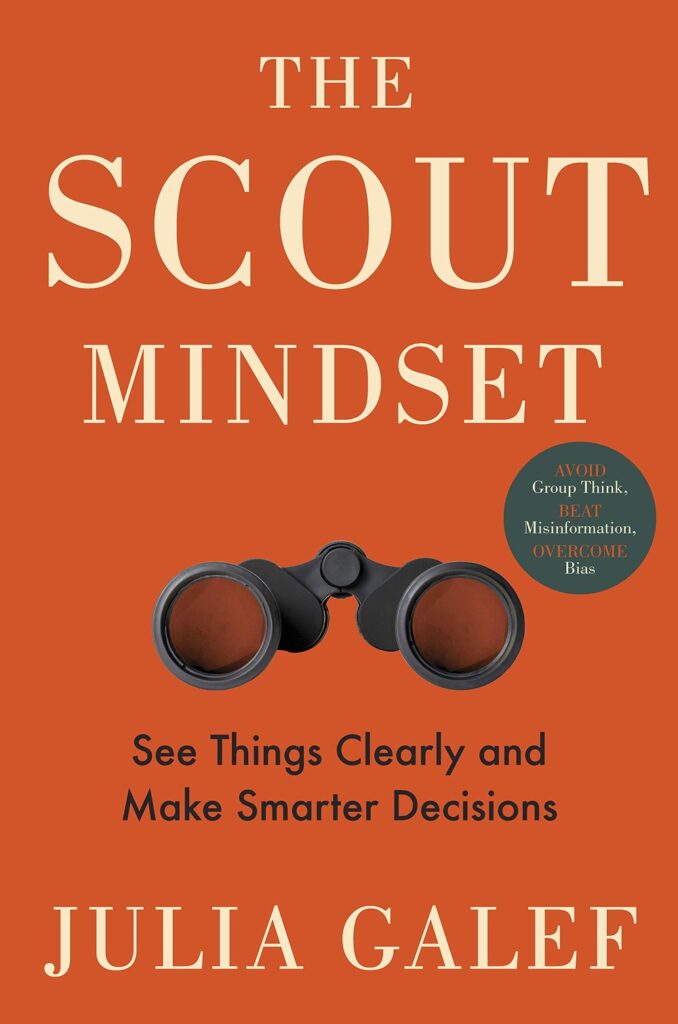Sharing my learnings from the book, The Scout Mindset by Julia Galef
The Scout Mindset by Julia Galef
In The Scout Mindset, Galef shows that what makes scouts better at getting things right isn’t that they’re smarter or more knowledgeable than everyone else. It’s a handful of emotional skills, habits, and ways of looking at the world—which anyone can learn. With fascinating examples ranging from how to survive being stranded in the middle of the ocean, to how Jeff Bezos avoids overconfidence, to how superforecasters outperform CIA operatives, to Reddit threads and modern partisan politics, Galef explores why our brains deceive us and what we can do to change the way we think.

- Imagine that the world is a battlefield – and that on this battlefield there are two types of people: soldiers and scouts.
- soldiers believe there is only one way of seeing the world – and that is their way. They’re ready to attack anything or anyone that contradicts their worldview.
- scouts have no interest in attacking. Their job is to check out the lie of the land, to create an accurate map of the battlefield, to establish the facts, regardless of whether those facts reinforce or contradict what they want to be true.
- we’re both solders and scouts but each of us tends to approach life either a bit more like a soldier or a bit more like a scout. Learn how to think more like a scout and less like a soldier.
- the main drawback of the soldier mindset is that it can blind us to the truth. If we’re so busy seeing what we want to see and seeking evidence that backs up what we already believe, then we may never see what’s really there or have our beliefs changed for the better.
- A soldier mindset has benefits. Some of those benefits are social. Others are emotional. what might be the biggest social benefit is belonging.
- the soldier mindset is a way of maintaining community. If you defend your beliefs, if you always toe the community line, then you’ll always belong.
- your soldier mindset provides you with comfort. It helps you disregard uncomfortable negative emotions by disregarding versions of reality that might generate uncomfortable negative emotions.
- Scouts go about things differently. They believe that the best way to be right – not just to feel right, or to believe that you’re right, but to actually be in possession of an accurate picture of objective reality – is to get good at being wrong. The goal is to be right: to be in possession of that accurate picture.
- The first step is learning to admit when you’re wrong. Admitting when you’re wrong is a kind of exercise: it’ll strengthen your ability to spot when you’re wrong, which, as you know, will improve your ability to get things right.
- But scouts don’t only admit their mistakes. They actively seek to prove themselves wrong. Remember: scouts are after the most accurate, objective picture of reality possible – which means taking the possibility that they’re wrong as seriously as they possibility that someone else might be wrong.
- There are several thought experiments you can employ to keep your inherent biases in check. Remember, though, for these to work, you really do have to put yourself in an imaginary world and see what your reaction would be.
- a selective skeptic test – a thought experiment where you imagine that the evidence supports an opposing view and then ask yourself, Would I still find it believable?
- outsider test – They considered what a completely new, total outsider would do in their shoes.
- status quo bias test – asks you to look at an unfamiliar situation from the inside.
- you can develop a scout identity and take pride in that. Having an identity pressures you to defend your beliefs. But if you believe in being a scout – in remaining open to new information and developing an accurate picture of the world – then you’ll always have beliefs worth defending, even if what you end up believing tomorrow isn’t what you believe today.


Leave a Reply